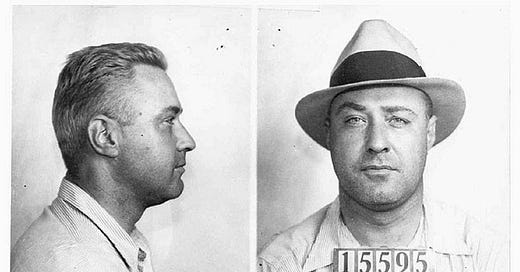American Gangsters: Machine Gun Kelly
The criminal career of America's most dangerous gun-toting gangster.
George “Machine Gun” Kelly Barnes was one of the most notorious public enemies in 1930s America. From Texas to Mississippi to Iowa, the bank robber inflicted a reign of terror.
Early life
He was born on July 18, 1895 in Memphis. Unlike many other gangsters of the era, he came from an affluent background. His upbringing was relatively normal. Little else is known of his early life, except that he studied agriculture at Mississippi State University in 1917. A terrible student, he earned Cs and caused trouble in class. Dissatisfied with school, he became a dropout and married a fellow student, a young woman named Geneva Ramsey. The two got married quickly, and had two sons.
Bootlegging
Without much formal education, the 19-year-old Kelly began performing various odd jobs. He worked as a cab driver in Memphis, but it was insufficient to pay the bills. His wife grew impatient with his financial woes, and divorced him. Broke and heartbroken, Kelly looked for other ways to make some fast cash. As Prohibition began, he entered the lucrative but illegal market of bootlegging. This incurred the scrutiny of Memphis police, as well as his affluent family. So Kelly distanced himself from his family, changing his name and moving out West in search of fortune. En route, he managed to evade arrest, earning him a reputation in the criminal underworld. But in 1928, the law caught up to him. He was arrested for smuggling alcohol into an Indian reservation. Because of this, he received a three-year sentence at Leavenworth Penitentiary in Kansas. He managed to secure an early release due to his good behavior.
Bad wife
Shortly after prison, Kelly met another woman named Kathryn Thorne. A seasoned criminal herself, she had already been married three times. Her last husband committed suicide in very suspicious circumstances, possibly having been murdered by Kathryn. At the time she meet Machine Gun Kelly, Thorne was the mistress of another man, a small-time bootlegger named Steve Anderson. She got romantically involved with Kelly, and the two became inseparable. They got married in Minneapolis in 1930. Kathryn was instrumental in crafting the persona of Machine Gun Kelly. She supplied her husband with his first machine gun. At local bars, she boastfully handed out spent machine gun cartridges that were allegedly used by her husband.
Public enemy
Although he had robbed a few banks, Kelly did not gain national attention until July of 1933. Kelly and his wife embarked on their most nefarious plot to date. They planned to kidnap a rich oil tycoon from Oklahoma City, named Charles Frederick Urschel. On July 22, Urschel was playing a game of bridge with his friends at a luxury residence. Their wives were present as well. Kelly and his goons stormed into the party, carrying machine guns in hand. Kelly was aided by another dangerous criminal named Albert L. Bates. The gangsters robbed the men, and took Urschel hostage. They issued a ransom of $200,000, which would be about four million dollars in today’s money. The FBI has since published the ransom letter. The Urschel family agreed to pay the money. Eight days later, the cash was dropped off in twenty dollar bills at a hotel in Kansas City. The next day, the gangster remained true to their word. They released Urschel at Norman, Oklahoma. The Urschel kidnapping transformed Machine Gun Kelly into one of America’s most dangerous and frightening criminals. The FBI declared him public enemy number one. The Bureau’s Director, J. Edgar Hoover, put all of his best agents on the case. Wanted posters were found everywhere, describing Kelly as an expert user of machine guns. During his kidnapping, Urschel had taken diligent steps to collect information. He recalled background sounds, counted footsteps, and purposely left his fingerprints on physical surfaces. This information was absolutely essential for the FBI, allowing agents to identify a possible location at Paradise, Texas. The farmhouse turned out to be the wrong location, but it did allow FBI agents to make many related arrests.
Arrest
In the aftermath of the crime, Kelly and his wife fled from state to state. But the FBI continued to close in. Many arrests were made. In August, Bates was arrested in Denver, Colorado. He was caught in possession of $660 and a machine gun. Around this time, the FBI recovered all kinds of stolen money across America. In the early hours of September 26, after receiving a tip, the FBI raided a residence in Memphis. Machine Gun Kelly was finally captured. The gangster was found unarmed. According to legend, he shouted, “Don’t shoot, G-Men!” Apparently, he had been suffering from a hangover, and was caught still in his pajamas. Kelly and his wife were taken to Oklahoma City. On October 12, the criminal couple were convinced and sentenced to life in prison. In total, twenty-one people were convinced for crimes related to the case. This included six life sentences. Other sentences added up to a total of 58 years in jail. Kelly was taken to Leavenworth Prison in Kansas. His wife was taken to a federal prison in Cincinnati. In jail, Kelly threatened to attempt an escape. So authorities transferred the gangster to the unbreakable prison of Alcatraz. There, he was inmate number 117. At the infamous Rock, Kelly became remorseful for his crimes, and wrote letters to the Urschel family. In 1951, he was transferred back to Leavenworth. Three years later, he died of a heart attack on his birthday in 1954. Kathryn managed to finish out her sentence, and was released from prison in 1958. After years behind bars, she was successfully rehabilitated. The woman found honest work as a bookkeeper at the Oklahoma County Poor Farm, which served a dual function of nursing home and hospital. She died in 1985, at the age of 81.
Learn More





